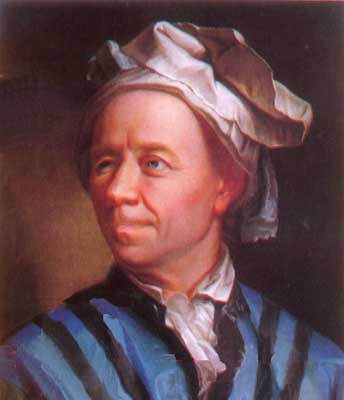

Leonard Euler (1707-1783) corresponded with Christian Goldbach about the conjecture now named after the latter.
Here is one of the trickiest unanswered questions in mathematics:
Can every even whole number greater than 2 be written as the sum of two primes?
A prime is a whole number which is only divisible by 1 and itself. Let's try with a few examples:
- 4 = 2 + 2 and 2 is a prime, so the answer to the question is "yes" for the number 4.
- 6 = 3 + 3 and 3 is prime, so it's "yes" for 6 also.
- 8 = 3 + 5, 5 is a prime too, so it's another "yes".
If you keep on trying you will find that it seems that every even number greater than 2 can indeed be written as the sum of two primes. This is also the conclusion that the Prussian amateur mathematician and historian Christian Goldbach arrived at in 1742. He wrote about his idea to the famous mathematician Leonhard Euler, who at first treated the letter with some disdain, regarding the result as trivial. That wasn't very wise of Euler: the Goldbach conjecture, as it's become known, remains unproven to this day.
In 1938 Nils Pipping showed that the Goldbach conjecture is true for even numbers up to and including 100,000. The latest result, established using a computer search, shows it is true for even numbers up to and including 4,000,000,000,000,000,000 — that's a huge number, but for mathematicians it isn't good enough. Only a general proof will do.
There is a similar question, however, that has been proven. The weak Goldbach conjecture says that every odd whole number greater than 5 can be written as the sum of three primes. Again we can see that this is true for the first few odd numbers greater than 5:
- 7 = 3 + 2 + 2
- 11 = 3 + 3 + 5
- 13 = 3 + 5 + 5
- 17 = 5 + 5 + 7.
Until very recently the result had only been verified for odd numbers greater than 2 x 101346 — that's a number with 1,347 digits! But then, in 2013, the Peruvian mathematician Harald Helfgott closed the enormous gap and proved that the result is true for all odd numbers greater than 5.
The weak and strong Goldbach conjectures are just two of many questions from number theory that are easy to state but very hard to solve. See here to read about some more, and here to find out more about the Goldbach conjecture and our Goldbach calculator.